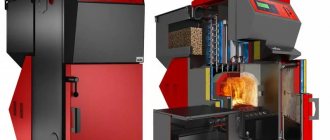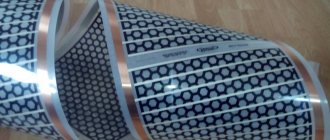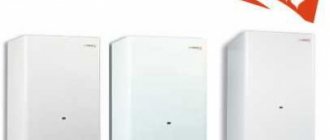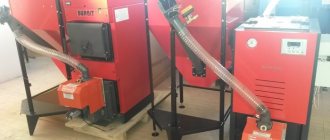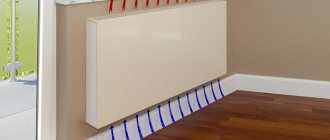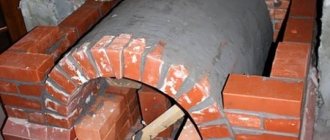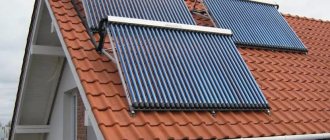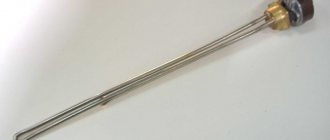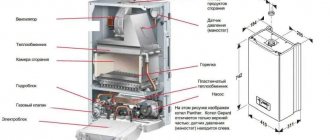Homeowners who use solid fuel stoves for heating know firsthand such a nuisance as the room cooling down after the wood in the stove burns out. This can happen at night or during a prolonged absence of the owners.
In these cases, a wood-electricity combination boiler for heating a private home will help maintain the temperature. Such heat sources are equipped with automation that monitors the system - if the stove goes out and the water in the boiler cools down, it sends a command to turn on the electric heating elements.
Externally, a combination boiler is practically no different from a standard one Source darizz.access.ly
Application of combi boilers
Today, such devices are universal and at the same time economical devices for autonomous heating at home. Their main trump card is that they are not tied to one type of fuel. If such a boiler runs on electricity, then during a sudden power outage you can light the wood stove to keep the house warm and vice versa.
Buying a combination boiler solves several problems :
- If there is no main gas pipeline in the village where the house is built, then it is possible to use two alternative types of energy at once - solid fuel and electricity.
- If a country house is connected to a weak power supply line, a combination boiler is almost an ideal option - you won’t have to freeze if you need to turn on another powerful electrical appliance for a long time.
- Eliminates cooling of the house when using solid fuel. Such a unit, connected to water heating, helps maintain a constant temperature in the system: if the fuel burns out, the boiler will automatically smoothly switch to heating through the heating element. This is especially convenient at night: you don’t have to get up and add wood to the stove’s firebox.
When a conventional boiler cools down, it must be lit immediately so as not to lose heat Source iobogrev.ru
Rating of the best solid fuel heating boilers of 2021
Classic solid fuel heating boilers are unpretentious in maintenance, do not depend on external power sources and are capable of reliably heating rooms. Excellent for heating residential buildings, as well as for heating industrial premises, country houses for seasonal residence, and summer cottages.
1
Teplodar Cooper Praktik 8
Rating 2022: 4.9
- Power 8 kW
- Heating area 80 sq.m
- Type of fuel: solid fuel
Average price: 13,100 rub.
The best single-circuit solid fuel boiler of a classic design, floor-mounted. Power 8 kW. Capable of reliably heating rooms up to 80 square meters. m. Completely non-volatile, does not require a power supply. Works on such types of fuel as: firewood, coal, peat briquettes. Features include a steel heat exchanger and an open combustion chamber. To maintain the coolant temperature at night and in emergency modes, it is additionally equipped with an electric heating element.
Principle of operation
The wood-electricity combination boiler operates according to the following algorithm :
- Melting and heating of the unit occurs in the traditional way. During the combustion of solid fuel (wood, coal, briquettes), the water temperature is maintained using a thermostat together with a sensor. Electric heating elements do not work at this moment.
- If you do not add fuel to the firebox in time, then after it burns out, the temperature of the water in the system gradually decreases to a certain value, after which a sensor is triggered, which closes the control contacts and the heating element (one or more) turns on. From this moment on, the boiler begins to operate from the mains.
- After the next loading of fuel, the water in the pipes is heated from the side of the firebox and, upon reaching the set temperature, the sensor is triggered again, but this time to turn off the heating elements. The electrical part of the boiler is again inactive until the water temperature decreases again.
Most often, the electric heater in a combination boiler is designed as an auxiliary heating device, but if you wish, you can choose a boiler model that, if necessary, can work continuously, providing hot water to the house and heating system.
A heating element with a sensor connected to a heat exchanger Source anapasunsity.ru
Features of using an electric boiler
The device, operating from a household network, heats rooms by converting current into thermal energy.
The equipment is used for heating and organizing autonomous hot water supply in the house. Electric boilers are equipped with additional functions that simplify the management of the system.
This type of device is environmentally friendly and safe. However, a stable power supply voltage is required.
Types of equipment
Manufacturers produce 3 types of such boilers: classic with heating elements, electrode and induction.
The first ones are equipped with a thermal heating element - a metal tube, which is filled with quartz sand. It contains a spiral made of tungsten or nichrome, its ends are brought out to connect wires that supply voltage.
The heating elements are located in the tank of the boiler unit. The power depends on the number of heaters. The device is equipped with a control unit whose sensors monitor temperature and pressure.
Electrode boilers are units coated with insulating material. They are more compact in size. One or more electrodes are placed inside the device, to which phase wires are connected.
Zero or grounding is fixed to the housing. The units have high efficiency and are characterized by rapid heating of the coolant. Heating with a heating element boiler is a less effective method, but such devices are the cheapest and easiest to maintain.
Devices operating by electromagnetic induction have a coil in their design. When current flows, the core heats up and the generated heat is transferred to the liquid circulating in the heating system.
The units are demanding on the purity of water: it must be distilled.
How boilers work
The operating principles of electrical equipment depend on the design of the devices.
The temperature of the liquid in the heating system is increased by:
- when heat is generated by current, if tubular heating elements are used;
- due to electromagnetic induction;
- by passing current through the liquid circulating in the device.
A pump installed in the main pipeline pumps heated water from the boiler through it to the heat exchangers, which are located in the room. The temperature of the liquid in the system is adjusted using an automation unit that ensures periodic switching on of the device.
The units are equipped with a set of sensors that monitor operating parameters and allow adjustments to be made to them. To facilitate setup and control, programmable room thermostats are connected to the devices.
Advantages and disadvantages
Advantages of electric boilers:
- there is no need to install a chimney or exhaust hood;
- no need to equip a separate room;
- environmental Safety;
- small dimensions.
Flaws:
- energy dependence;
- high cost of electricity;
- sensitivity to voltage changes;
- the need to install additional wiring.
For stable operation of the installation, stabilizers or uninterruptible power supplies are needed.
By the way, heating boilers for private houses using wood and electricity have high efficiency and energy independence.
Pros and cons of combi boilers
When choosing any equipment, you need to focus not only on its positive aspects, but also study its disadvantages in order to understand which characteristics are more important to you.
Advantages
The advantages of wood-electricity devices compared to heating units that operate only on one type of fuel are obvious:
- Versatility of equipment. Electricity for a boiler can be either the main energy source or an auxiliary one - which priority will be decided only by you.
- Autonomy . There is no need for constant monitoring, since the boiler is equipped with automation.
- Economical . Firewood is one of the most affordable types of fuel in many regions of the country, and it is now almost impossible to find a house without an electrical connection.
- Convenient design . Constantly maintaining the set water temperature with minimal energy consumption.
- If a two-tariff meter is installed, you can program the boiler to turn on the heating elements only to maintain heat at night, when the tariff is much lower and thereby save electricity consumption .
With proper load distribution, a two-tariff meter saves from 30 to 65% on electricity bills Source zinoti.lt
- Long service life . Such boilers, when properly operated, operate for up to 25 years.
- The production of models with built-in pipes for the possibility of connecting a “warm floor” system .
Important! Wood-electric boilers operate effectively even in low-power modes.
Flaws
With all the advantages, such boilers also have disadvantages:
- Separate room . Units of this type require their own boiler room and an extension for fuel storage.
- Heavy weight . Most often, boilers are made of cast iron and require a solid concrete base to place it on.
- Device complexity . This factor affects the price of the boiler: it is 20-30% higher than the cost of units operating on one fuel.
On a note! Electric heating elements of most combination boilers are designed mainly to maintain heat. In winter, at external temperatures below –5 °C, they cannot completely replace the combustion of solid fuel due to their low power. If you plan to use electric heaters for a long time, you need to look for boiler models that operate on three-phase power (if this is installed in the house).
Powerful boilers are connected to a three-phase network Source tk-assortiment.ru
Which equipment is better to choose?
It is impossible to use a solid fuel boiler if there is no smoke removal system and space for storing energy. It makes no sense to install an electric unit if there are regular interruptions in the household network.
Solid fuel systems with manual loading mode cannot operate in a maintenance rhythm. When the energy carrier burns out, the boiler is deactivated, which leads to the cooling of the liquid circulating along the heating line.
If you are not constantly in the house, it is better to choose electrical equipment. This type of device must be installed even if there is no space for mounting a solid fuel unit.
To compensate for the disadvantages of one device with the advantages of the second, you can make a combined system consisting of both types of devices. However, the installation must be configured correctly.
Recommendations when choosing a boiler
Today the market offers a wide range of universal boilers, which differ in power, performance, design and configuration. But before purchasing such a unit, you need to weigh the pros and cons, and it is also useful to listen to the recommendations of professionals in this matter.
When purchasing a boiler, you must consider the following:
- Power . It depends on the fuel that will be a priority.
- The volume of one fuel load and the size of the combustion chamber . The duration of firewood burning depends on this parameter.
- Firebox material . These parts are made of cast iron and steel. It is preferable to choose chambers made of cast iron, since they are not subject to deformation when heated and retain heat longer, unlike a steel exchanger.
Components for combined boilers Source winplast.ru
- Grate bars . Two types are used: standard cast iron and the same, but coated with ceramic. The latter are used mainly for bulk materials, which consume more oxygen during combustion, and accordingly, the temperature is created higher.
- Weight and size . Typically, the body of such boilers is made of cast iron, which makes them much heavier than their “brothers”.
Advice! When buying a heating device, you need to take into account the area of the house. You should not purchase a boiler “with a power reserve”, as this will entail an overpayment - both during purchase and during operation.
Reviews
Reviews about combination boilers are mostly positive. In order to fully realize their advantages, it is necessary to choose the right type of structure.
In some regions, electricity is more expensive than gas, so you need to choose a boiler that uses gas as the main fuel.
Solid-state coolants can be used as secondary fuel if conditions permit.
Negative reviews are also present, but are mainly related to incorrect selection or violation of the rules and operating conditions.
Installation Requirements
Combination boilers in accordance with SNiP 41-01-2003 must meet the requirements. At the same time, they have their own characteristics during installation and operation, which distinguish them from similar units operating on a single fuel.
These requirements and recommendations must be known and followed in order for the boiler to operate safely.
Premises requirements
Wood and electric boilers for home heating are produced only in a floor-standing version and are installed in a boiler room with ventilation, and in accordance with other SNiP requirements:
- The walls in the room are made of non-combustible material.
- Equipment in the boiler room is installed no closer than 300 mm from the walls.
Example of boiler installation Source pingru.ru
Installation and operating conditions
A combined solid fuel boiler, like any other heating boiler, has the same installation and operating conditions.
First of all, it is worth understanding that placing such equipment in living rooms is impossible, since it can emit combustion products that are detrimental to human health.
Let's look at a few rules and recommendations that will help you choose the right installation location.
- Good ventilation. The room in which it is planned to install equipment of this type must be well ventilated so that all combustion products do not linger in the room and are not dispersed throughout the house. For this purpose, a special exhaust system is installed, which immediately draws out combustion products. The creation of a ventilation and exhaust system must necessarily provide for quick access for cleaning, because during operation it can become clogged and become less able to perform its function.
- Convenience of chimney installation. The best option would be to place the boiler as close to the external wall as possible. This is due to the fact that it will be much easier to remove the chimney, in addition, the supply of additional communications in the form of gas or electricity will also be greatly facilitated.
- Fire safety. Before installing the boiler, it is necessary to carefully prepare the room. It is not recommended to install floor structures on a subfloor; it is necessary to create a special stand made of concrete or brickwork. This will protect the subfloor from constant exposure to high temperatures. Wall-mounted models also need to be additionally protected by creating a kind of recess, which is assembled from fire-resistant materials with low thermal conductivity.
Technical design features
Combination heating boilers use four types of fuel:
- gas;
- electricity;
- solid energy carriers (coal, firewood);
- liquid fuel (fuel oil, used motor oils).
Contour
There are the following types of combined heating units: single-circuit and double-circuit.
The first ones have limited functionality - they provide heating for the house, while the double-circuit ones also heat the water.
Since universal boilers are made of cast iron, they are quite massive and therefore have only a floor-mounted design. Cast iron has high corrosion resistance, which is important if liquid fuel is burned.
Tank
Certain models include a hot water tank. Some dual-circuit devices are not equipped with a container; then they are connected to a reservoir, which is installed near the unit.
Almost all heating units are controlled automatically. This is very convenient because you can arbitrarily select a program, adjust parameters and monitor the operation of the equipment.
To ensure warm water supply, combined double-circuit boilers include a heat exchange unit, which is characterized by increased productivity - up to 250 liters of water every hour! It is possible to install a boiler. A double-circuit water heater has several outlets. This will allow you to make warm floors at home and produce heating using radiators.
What the owners say
In the process of making a decision about what kind of heating device is needed in the house, reviews of combined multi-fuel boilers will help you make your choice. Here are a few:
“The Japanese Kiturami boiler switches perfectly automatically from solid fuel to diesel. Heat dissipation is very good, no complaints!”
Alexander, Moscow region.
“The boiler is designed to work with wood, diesel fuel and gas. Due to constant significant “jumps” in pressure in the gas pipe, we mainly use wood heating. It heats wonderfully and there is no such dirt as when heating with peat or coal. Diesel fuel is the last “backup” option, we tried it only after installation.”
Sergey, Borisov.
“We bought a boiler that is heated with coal briquettes and runs on electricity. But our network voltage is constantly fluctuating, this can be seen even without measurements, the lights are blinking. That's why we mostly heat it with coal. There are no problems with dirt - the device itself and all the supplies for it “live” in the utility room. Despite the winter cold, the temperature in the house did not drop below +25°C! Satisfied."
Svetlana Naumenko, Moscow region.
“Having suffered from freezing every winter, the whole family decided to buy a combined solid fuel boiler with a water circuit. And if the men understood what kind of “beast” this was, then I was afraid - would I be able to control it? Moreover, it is expensive. However, the fears were in vain - they installed, showed, told and taught. Now we live in a warm place, and there are no problems with hot water!”
Nadezhda Nikolaevna, Kirov.
What is the price?
Prices for combination heating boilers can vary widely. Thus, the cheapest models will be “solid fuel-gas” and “wood-electricity” models, and the most expensive will be universal multi-fuel ones. The table below shows prices for popular boilers in Moscow.
| Model | power, kWt | Type of coolant | Price, rubles | Heated area, m2 | Number of circuits |
| Don KS-TG | 16 | Solid fuel gas | 19 794 | 160 | 1 |
| Don KS-DVT | 40 | 36 450 | 400 | 2 | |
| Kiturami TURBO | 34.9 | Diesel gas | 28 497 | 350 | 2 |
| Protherm Bizon NL | 30.5 | 38 030 | 270 | 1 | |
| Vaillant iroVIT VKO 328/5 | 40 | 72 848 | 300 | 1 |
In addition, cast iron boilers from the Italian manufacturer Ferroli and the German company Buderus, running on natural gas and diesel fuel, are popular.
Advantages of a boiler operating on different types of fuel
We examined economic feasibility in the previous section. Indeed, the cost of heating with different types of fuel may change, and then all your calculations will be reduced to zero. Emergency safety is also important: when you have 300% fuel reserves, life is somehow calmer. The same applies to technology: let’s say the gas burner is out of order, and the repairman will come only in a week. We heat with wood or electricity.
But there are other advantages:
- Complete energy independence. There are times when the main energy source cannot be purchased. There are many reasons, including illegal ones. You will still be able to provide your home with heat.
- Any heating system (especially with liquid coolant) is quite inertial. While you melt the wood (coal) and the gas burner comes into operation, a lot of time will pass. If you enter the house after a long absence, you want instant warm-up. You can start the express mode from an electric heater, then switch to economical heating from gas or solid fuel.
- You can dismantle the gas burner for maintenance without disturbing the heating mode.
Wood boiler for home
mihalich25 wrote: 1) perhaps 8 hours from the bookmark (I understand that this is not a completely correct question - it depends on the frost, the insulation of the house, but if we say outside -10 degrees the house is more or less insulated - inside the walls there is a 10cm min Rockwool stove, the same will happen on floors)
It’s hard to say without knowing the size of the house, but in general it’s better to estimate an average of 6 hours. But after 8 hours it will not be difficult to light the boiler, because the temperature and coals will still be there. Also, in order to avoid overheating or, conversely, underheating, it is worth choosing the right boiler power according to the area, heat loss and the number of radiators.
mihalich25 wrote: 2) all the equipment: the boiler itself + a circular pump + a pressure relief system (valve) wiring with batteries (there are no heat accumulators or other expensive and complex devices required)
It is advisable to install a coarse filter in front of the pump; it is cheap. It is better to buy a UPS or Inverter for the pump, otherwise without light there will be no heating. Or you can make a gravity-flow system, you can, of course, duplicate it so that it works both ways, but you will end up with a different pipe diameter. A hydraulic tank is also needed for a closed system to compensate for expansion. + The safety system also includes an automatic air vent valve and a pressure gauge. The boiler itself also has a monotherm.
mihalich25 wrote: 3)
Everything here will depend on the correctness of the calculations. If the boiler power matches the requirements of the house and the chimney is installed correctly. That is, with good traction. There shouldn't be any problems. I had situations with dry wood when I could not lower the temperature in the boiler below 80 degrees even with the vent closed when there was a strong wind and above-zero temperatures outside. In other cases, the adjustment works well and is reliable, like any mechanics. You just need to make sure that nothing interferes with the top lid closing, for example, a sliver of wood does not get in. Because, in principle, a small gap can even cause overheating. Now we heat like this, we heat it after lunch or in the evening, then I add more firewood before going to bed. They burn until the morning. After which I flood again after lunch. When minus 10 or more breaks decrease, the burning time also decreases. At -40 a couple of years ago, casting was enough for 3-3.5 hours. But I already wrote that my house is poorly insulated. In a well-insulated house, this will not be felt so much. I have -20 on the second floor, which is closed and the flowers are not heated and do not freeze. It is also important to choose the right pipes and connections, because it is better not to install simple threaded fittings, they will leak sooner or later. It is also worth installing a metal pipe a couple of meters from the boiler. Moreover, welding will be needed anyway, because there are connections there (I forgot the name, but in general welding will be needed. But in general, if you are afraid of overheating, you can make the entire system with metal pipes, they are not afraid of heat. However, for a short time, metal-plastic and similar pipes hold a high temperature up to 110. Specifically, nothing bad happened to me in 4 years. But the boiler, of course, needs to be cleaned; the chimney once a season is at least also advisable. It’s better to put a sandwich. In general, once you get used to it, lighting and operation become completely easy. Not worth it forget that in a few hours the house will not cool down, especially if it is well insulated. Therefore, there is no particular need to heat it around the clock. A simple dakon does not need a heat accumulator, but some use it. But it is only relevant for permanent residence, because otherwise it will heat up a ton of water to according to the link above, it will take a lot of time and firewood. Of course, it will probably take a week to cool down, in fact it is a boiler. Only without a heater. It provides a few more hours of hot water when the boiler has already burned out. Depending on the capacity. But then it won’t be easy to get the temperature up, IMHO it’s a controversial point. For a pyrolysis boiler, it is apparently important that the combustion does not stop, and they are installed to protect against overheating, and also from extinguishing.
